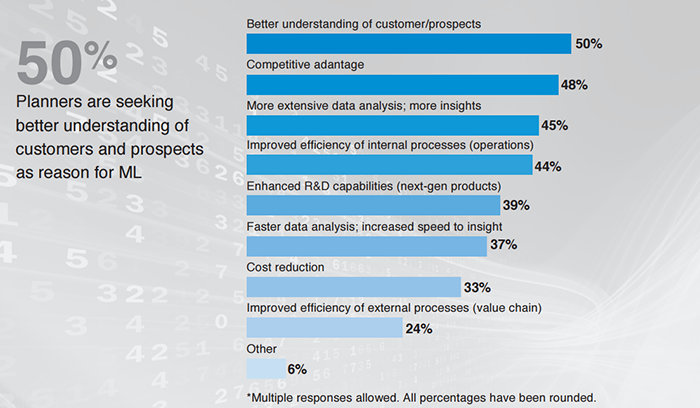Building better business intelligence with AI & Machine learning
August 08, 2017

We can all think of ways automation has created positive and negative effects in our lives. In our modern world, nearly every service and purchase we make today is automated on some level. Whether a transaction takes place in a branch, a store, or on our mobile devices, we have all begun to experience both the benefits and, at times, the agnostic dread of automation through AI and machine learning.
AI & Machine learning provide more than automation and ROI
While productivity may be up in some areas, over-automation has stripped the emotional attachments that we feel for brands. Once solely deployed for simple automation, businesses are now scrambling to deploy AI and machine learning to bring back that “personal touch” lost in the digital transformation revolution.
Machine learning and AI are not only the key to further automation, they also happen to be the only lifeline available when it comes to creating the perfect balance of automation and personalized service. AI acts as the decision and neural network storage mechanism, while machine learning helps it adapt and self-learn.
Google Cloud and MIT Technology Review teamed up in a recent survey that shows machine learning and AI are being deployed in organizations with noticeable and quantifiable results when it comes to learning and applying knowledge from their previously untapped data:
The pool consisted of 375 business and IT leaders from various organizations:
- 50% of machine learning implementers can quantify ROI, with half of them finding it recognizable at an early stage.
- 60% of respondents have machine-learning strategies in-flight, and nearly one-third characterize their initiatives as “mature.”
- Competitive advantage ranked among the top goals of machine-learning projects for 46% of current adopters and 48% of planners. 26% of current adopters said they’ve already gained a competitive edge from machine learning.
- Investment in machine learning is growing, with 26% of respondents committing more than 15% of their IT budgets to machine-learning projects.
Philippe Poutonnet, Product Marketing Lead at Google Cloud, said this about machine learning:
Across all these use cases, the premise is the same: As machine-learning models ingest and process large amounts of data, they get better and better at seeing patterns as well as the human eye but at a far greater scale. This capability can help many businesses unlock automated predictive-analytics capabilities, leading to smarter decisions, new operational efficiencies and better customer experiences. And that’s why machine learning provides ROI, which more than half of survey respondents said they can already demonstrate in their machine-learning projects.
Machine learning unlocks intelligence from everyday documents
The measurable benefits noted from the investment in AI and machine learning are exciting. From the same survey, 50% of these companies want their investments to help them understand their customers and prospects better.
This chart also shows that there is more value in the insights gained (45%), compared to the cost reduction demands (33%) of machine learning or AI solutions:

These leaders are looking to profit from the unknown knowledge from data that may have slipped in-between the cracks of their existing processes that were previously overlooked.
As automation takes over, human-touch is lost and they are on the mission to find it. Why?
It kills value and hurts brand loyalty, subsequently making virtually every service an easily-replaceable, app-like commodity. However, things are cheaper and workflows happen faster. We sacrifice individualized touch in the adoption of the digital transformation revolution, and it’s up to AI and machine learning to help us keep in touch with the data we call “customers.”
These innovative companies want to change that and have bolstered their efforts to show an investment in a personal relationship with each client, usually lost in traditional documents and automated processes.
Building better business intelligence with AI and Machine learning
The trouble is that all of this valuable information is locked on paper or encumbered in a variety of formats that may, or may not, work well together between digital environments – especially in organizations that have a variety of databases, systems, and repositories. This classic data deluge dilemma plagues many teams.
The traditional result is that employees often must retype the information by hand into these systems and suffer with a variety of work-arounds just to get their job done.
This creates inefficient workflows, often with error-prone results, that costs more to manage and maintain than a data capture or data transformation solution would produce in ROI and additional revenue-generation.
Now AI and machine learning are filling in these gaps while supplying teams with automation benefits and further insight into actionable business intelligence from previously unused data sets.
To build more value, these companies are now applying “context to text” with natural language processing technologies. Teams can profit from the backlog of existing information they already captured before but never used.
Real world applications
One example of how organizations are using ABBYY technology for everyday documents in the real world are the recent efforts at Vintage Mortgage Group.
The California-based mortgage broker needed to eliminate the slow, tedious error-prone process of manually recreating loan origination forms from PDFs. Since these origination forms are used every day for each and every loan, it made sense to look for a more automated solution.
Each of the fifteen banks we use has its own format and wording for the documentation required by Fanny Mae and Freddie Mac. Plus, we have to keep up with ever-changing government regulations. For security, the PDFs from each bank were locked – so we’d have to hand-type every document into Word to create a loan origination form that complied with each bank’s internal rules and the latest regulations.
CEO, Alex Gonzalez
The system accurately captures and converts PDFs into Microsoft Word documents for immediate import into Vintage Mortgage’s loan origination software. Sure, this cuts costs, but it also lowers response times for the representatives. This provides faster and more accommodating services to Vintage Mortgage’s clients with a personalized touch by spending less time on the computer.
The result: “It’s so much faster, so much more accurate and intuitive,” says Gonzales.
“What normally would have taken me half an hour is now done in about three minutes.”
